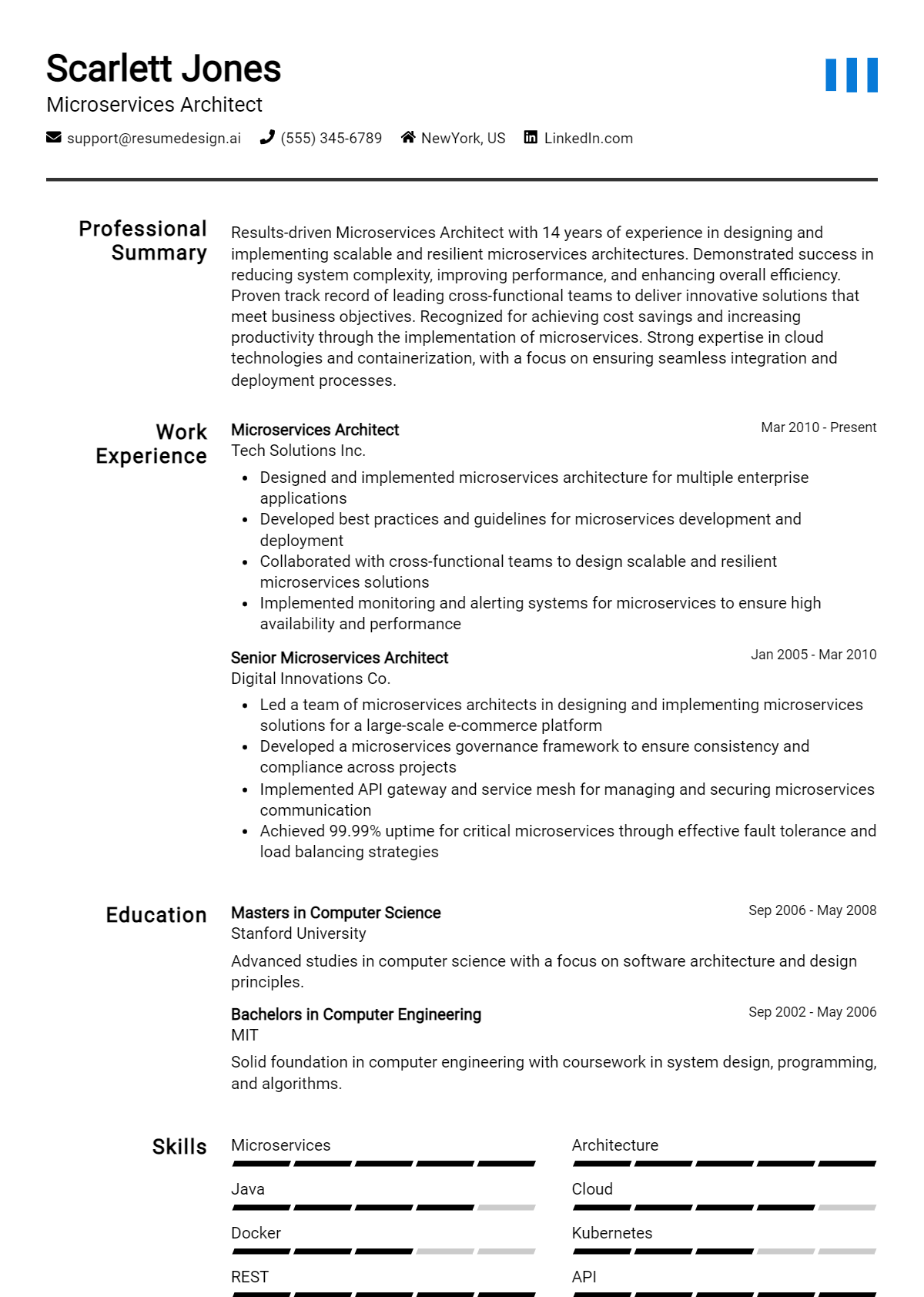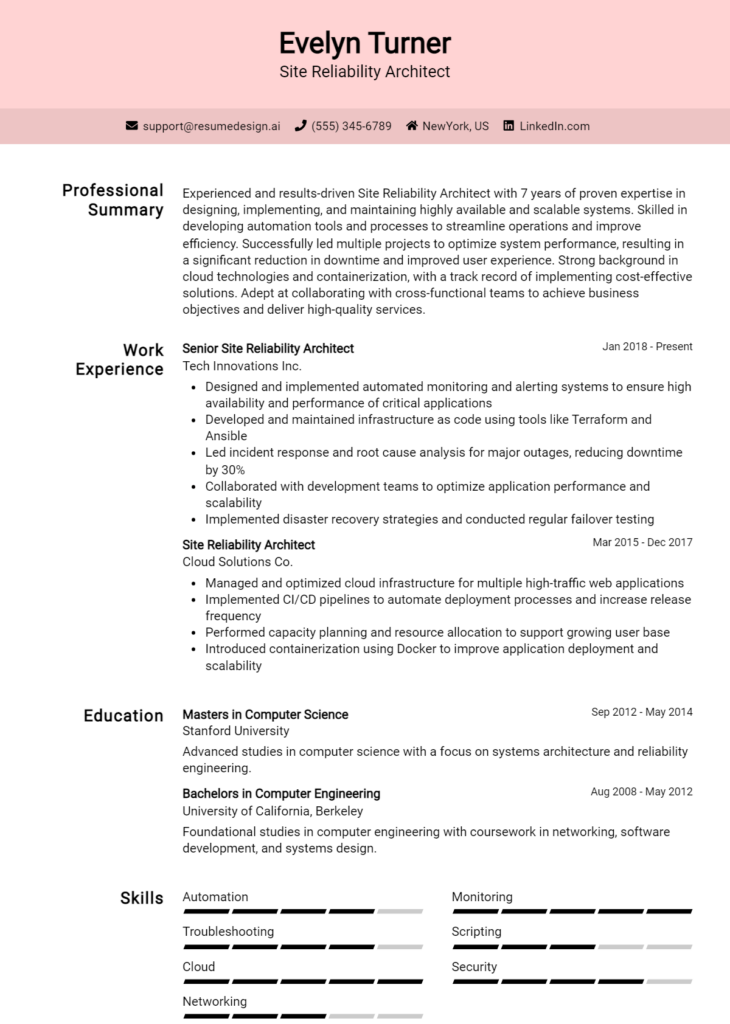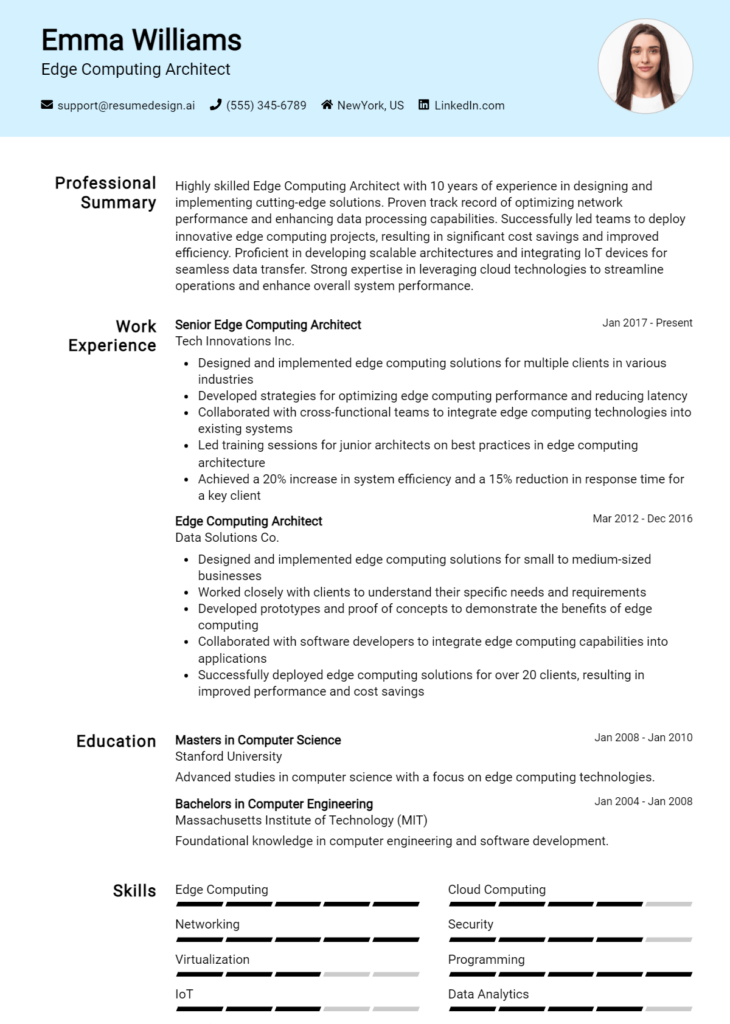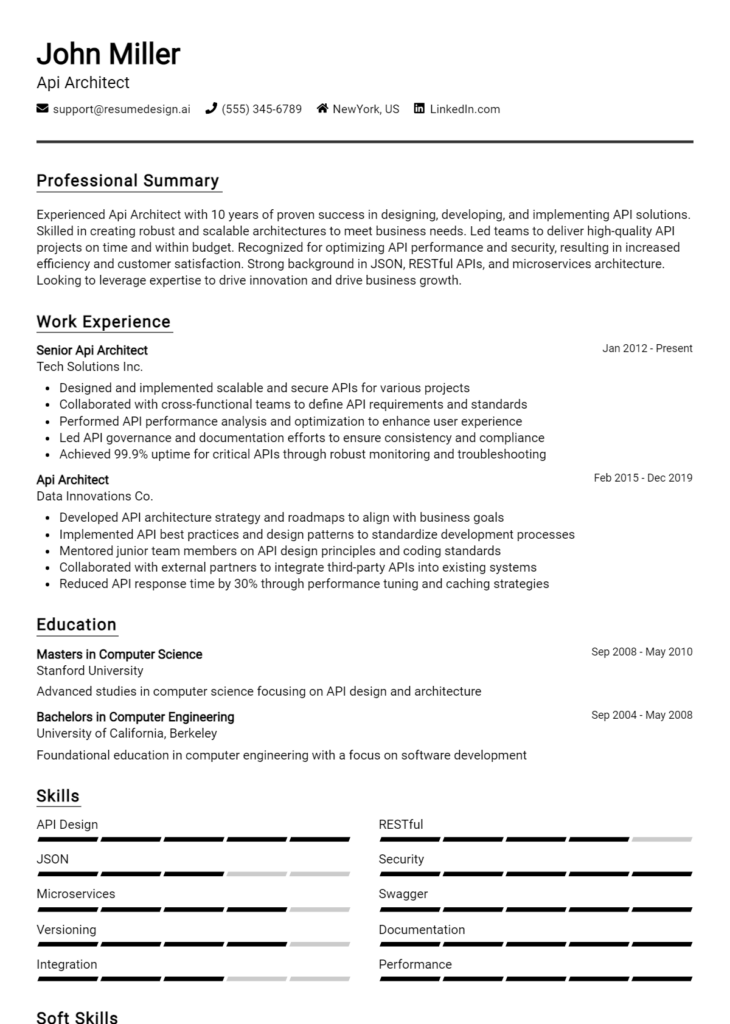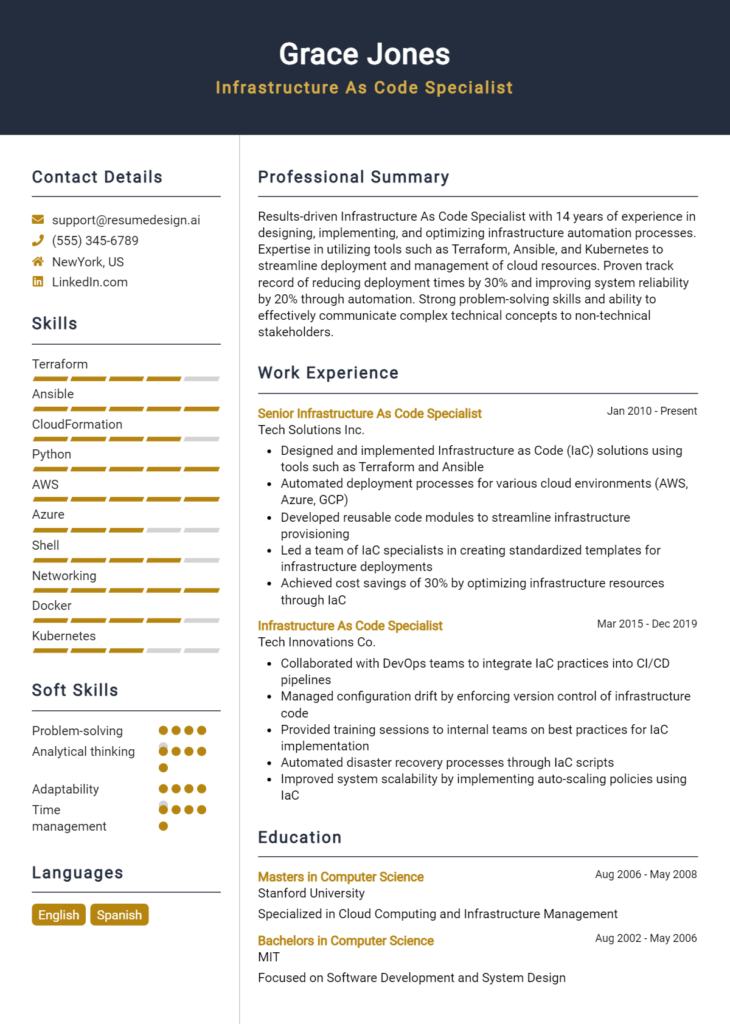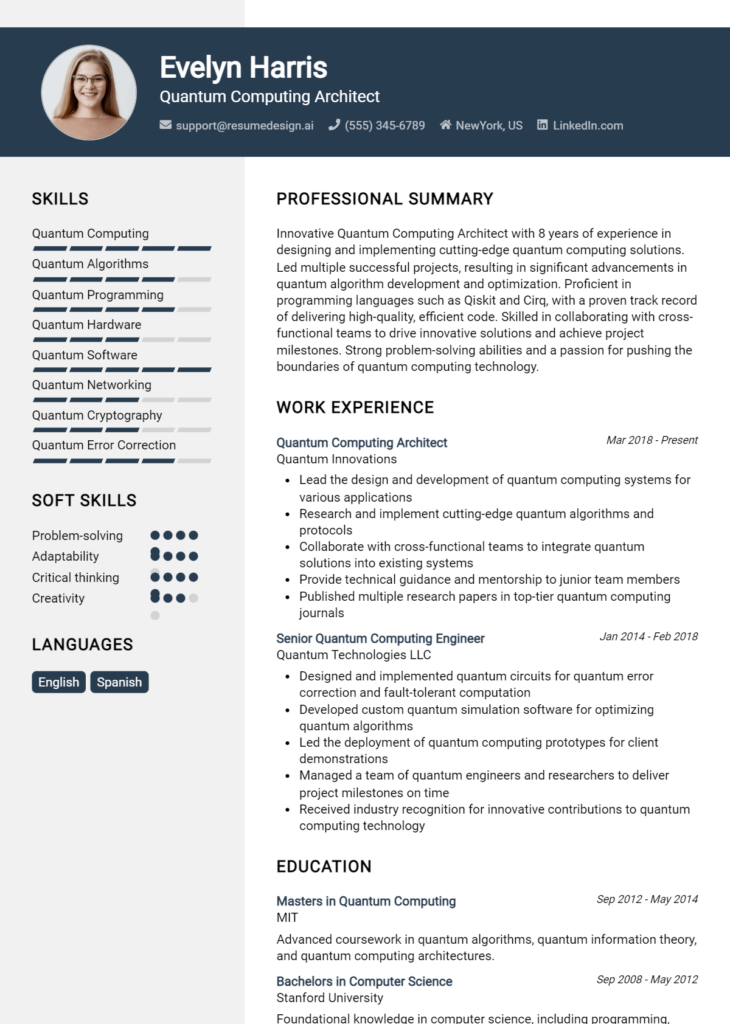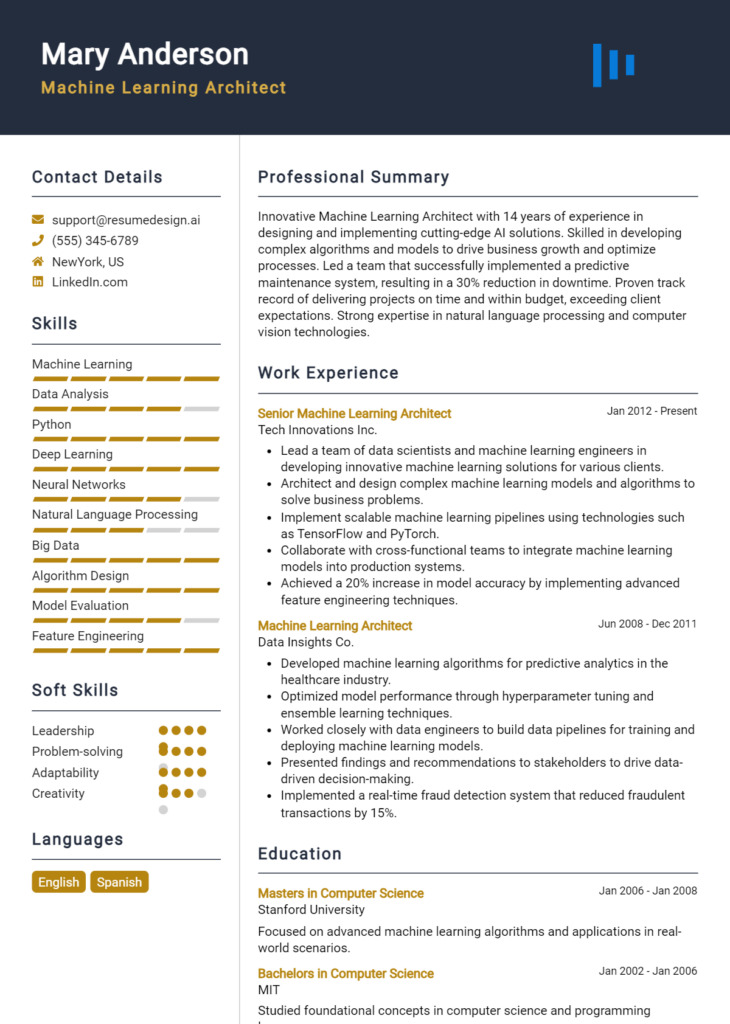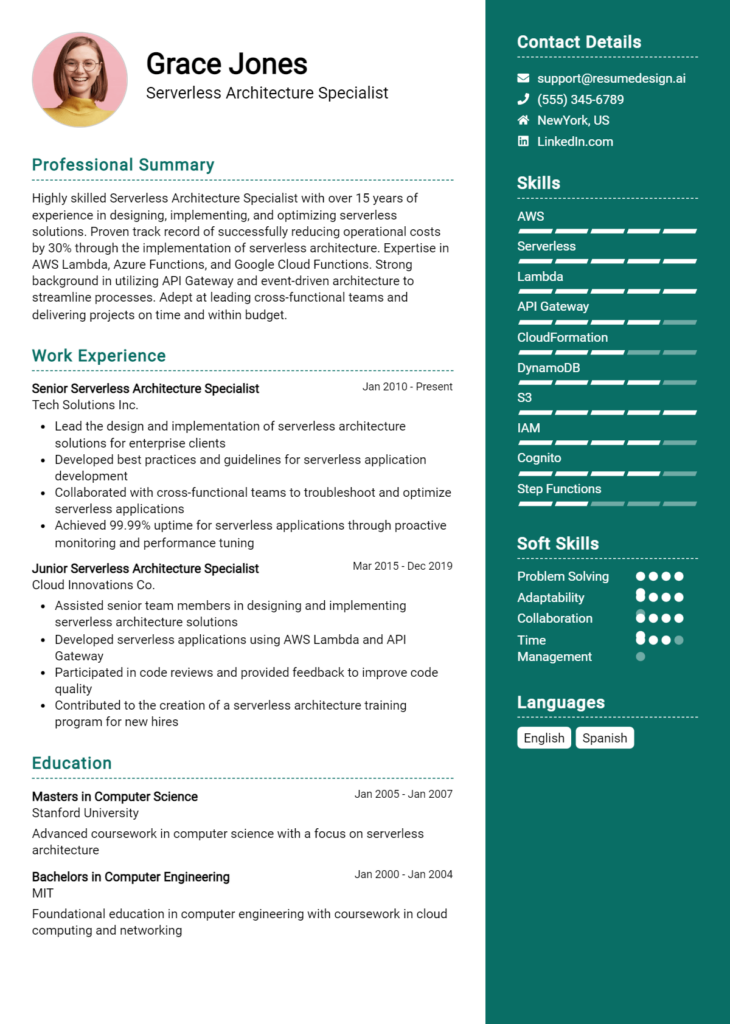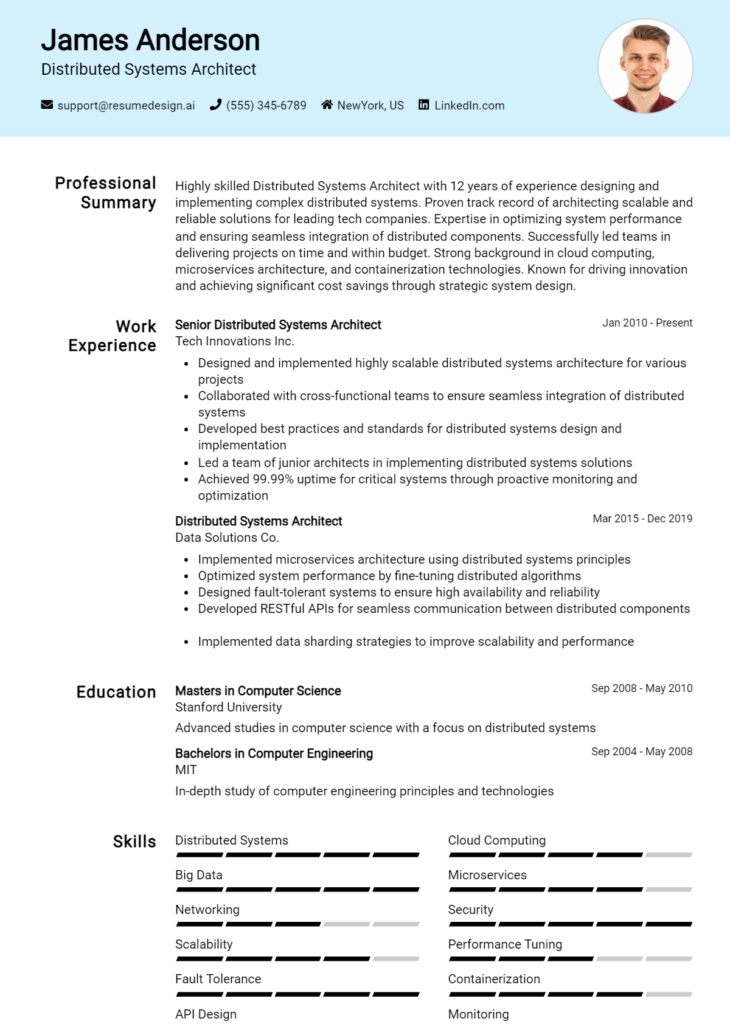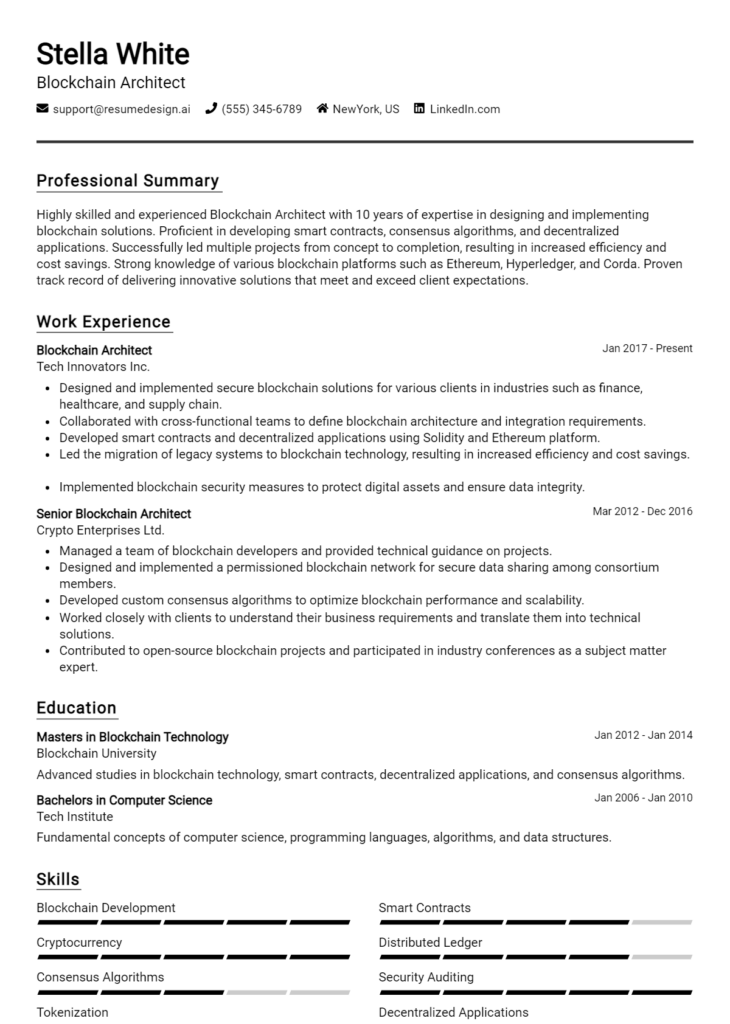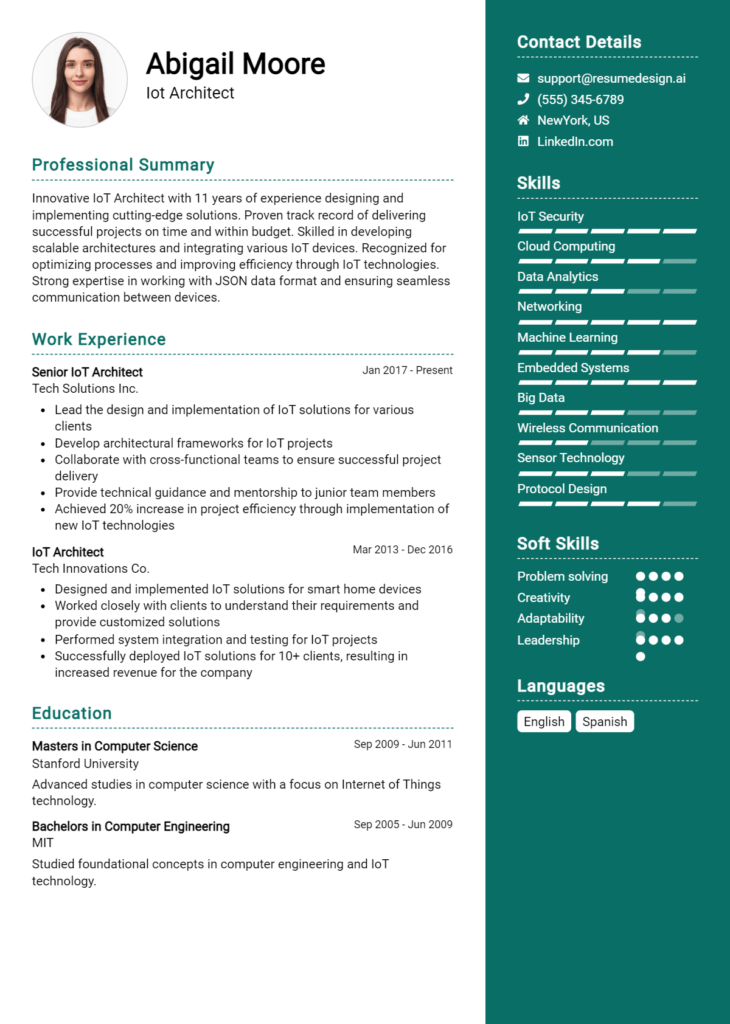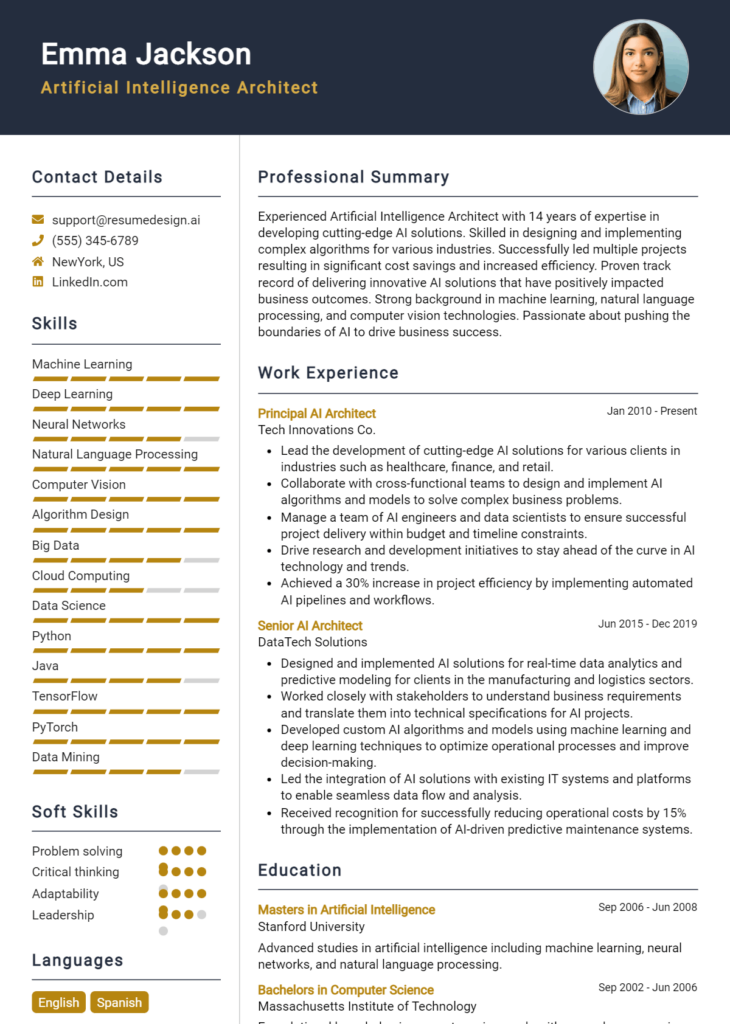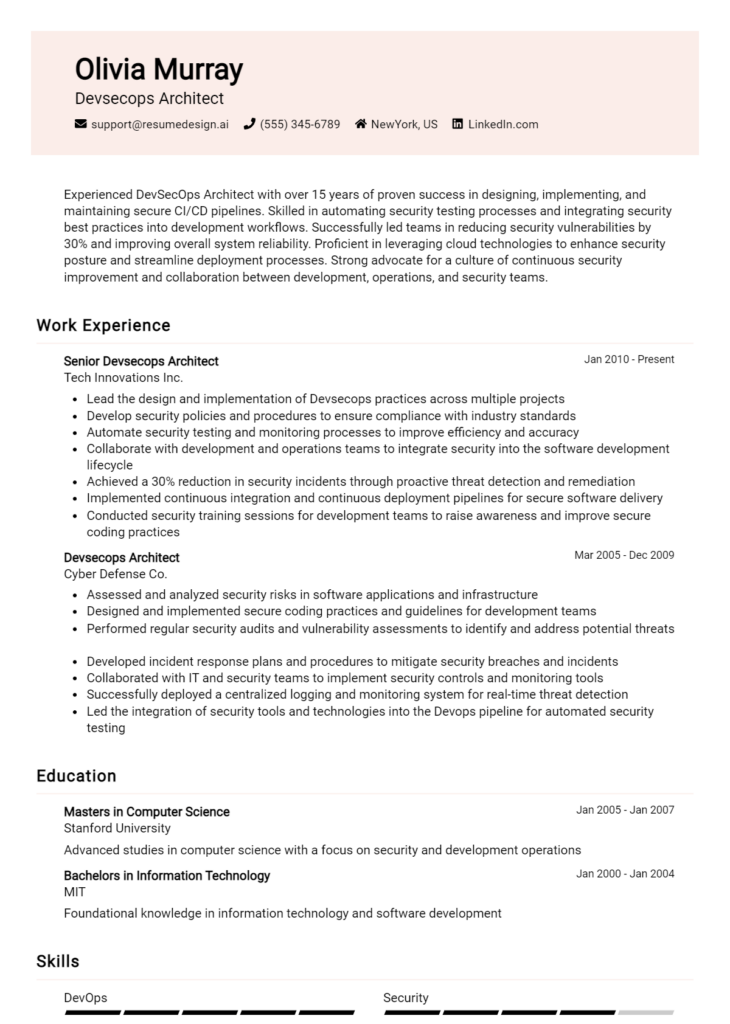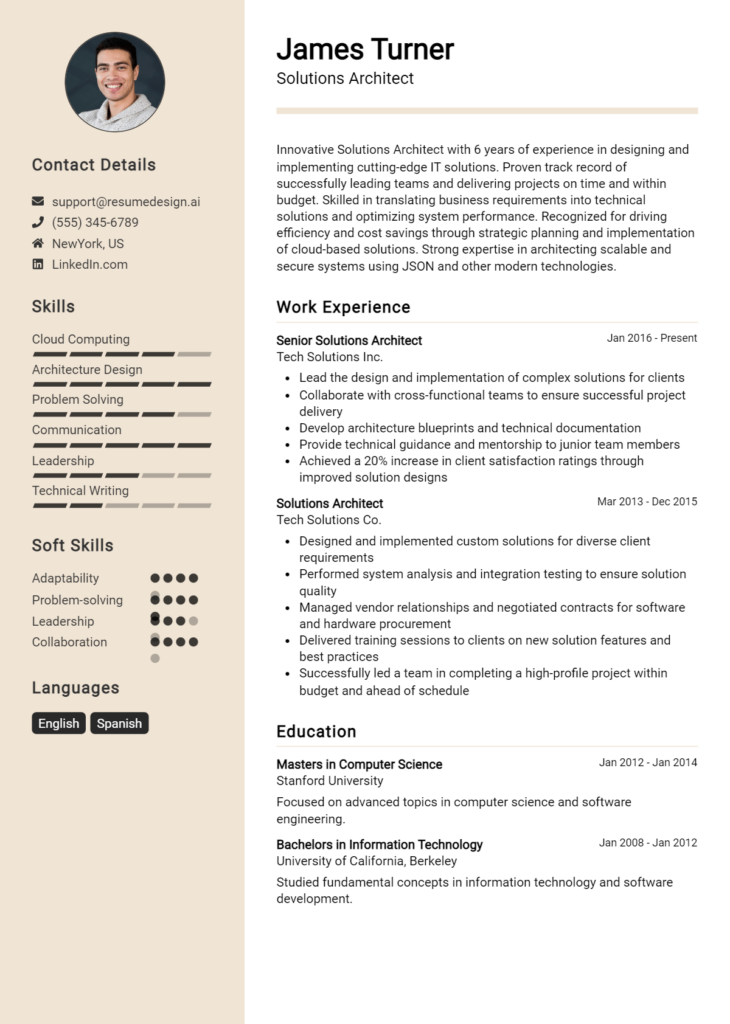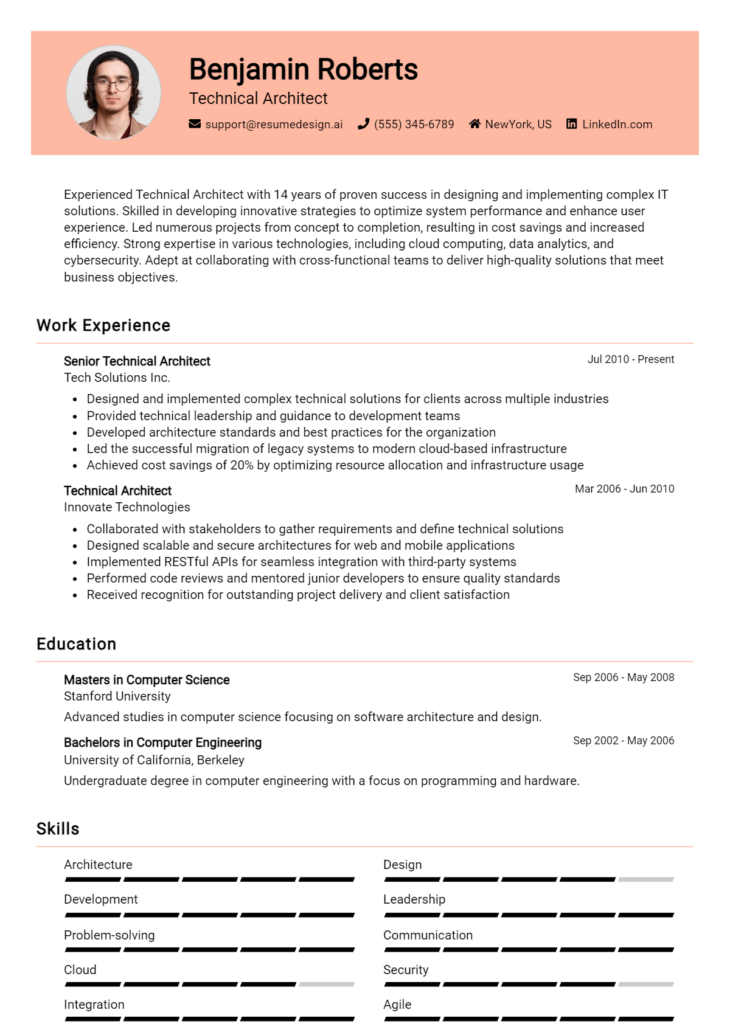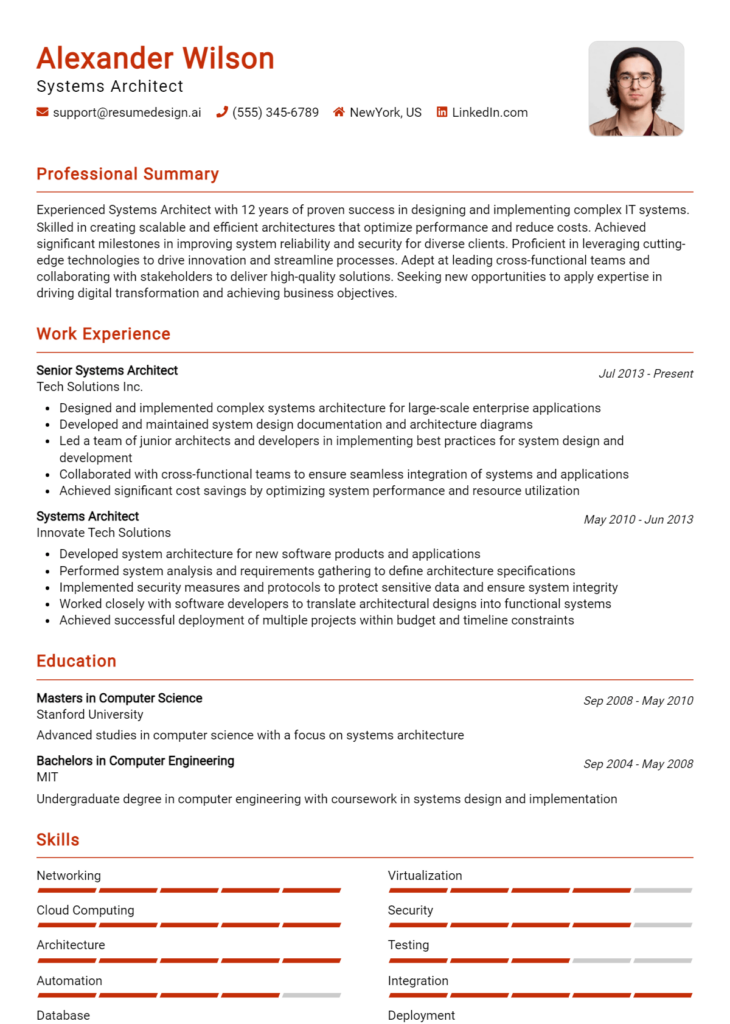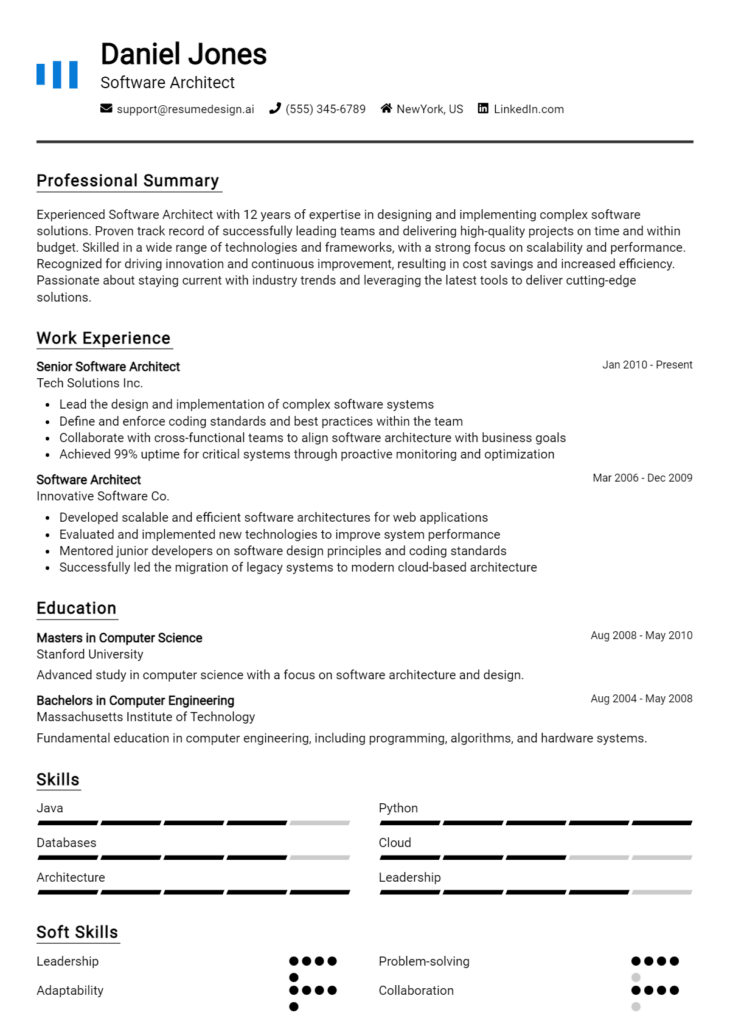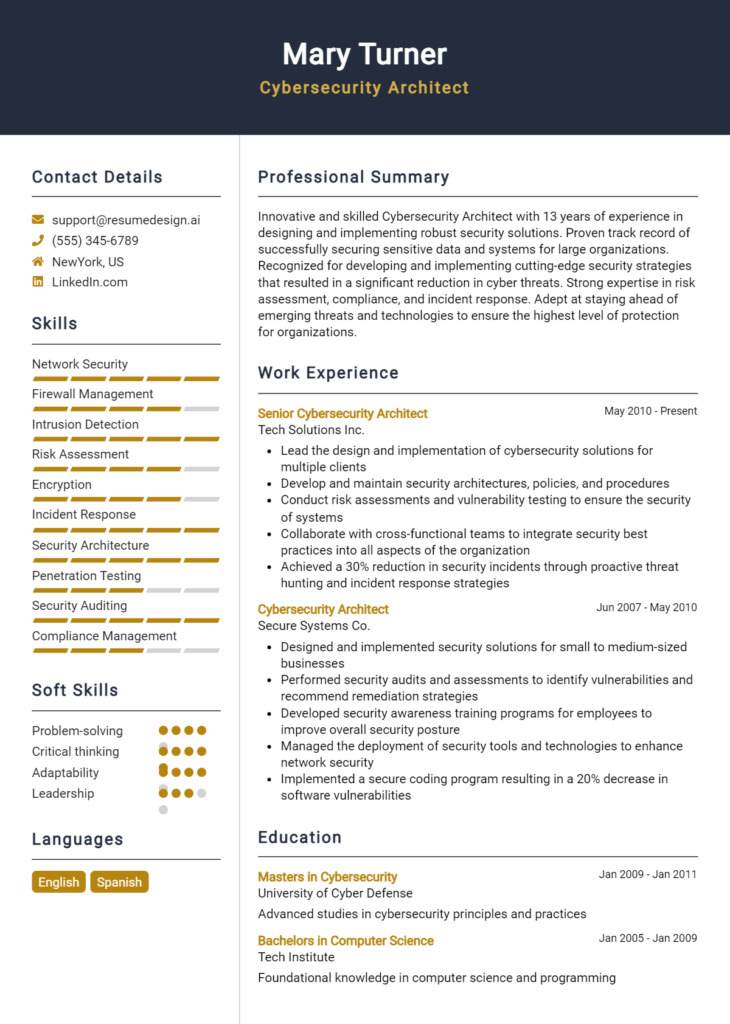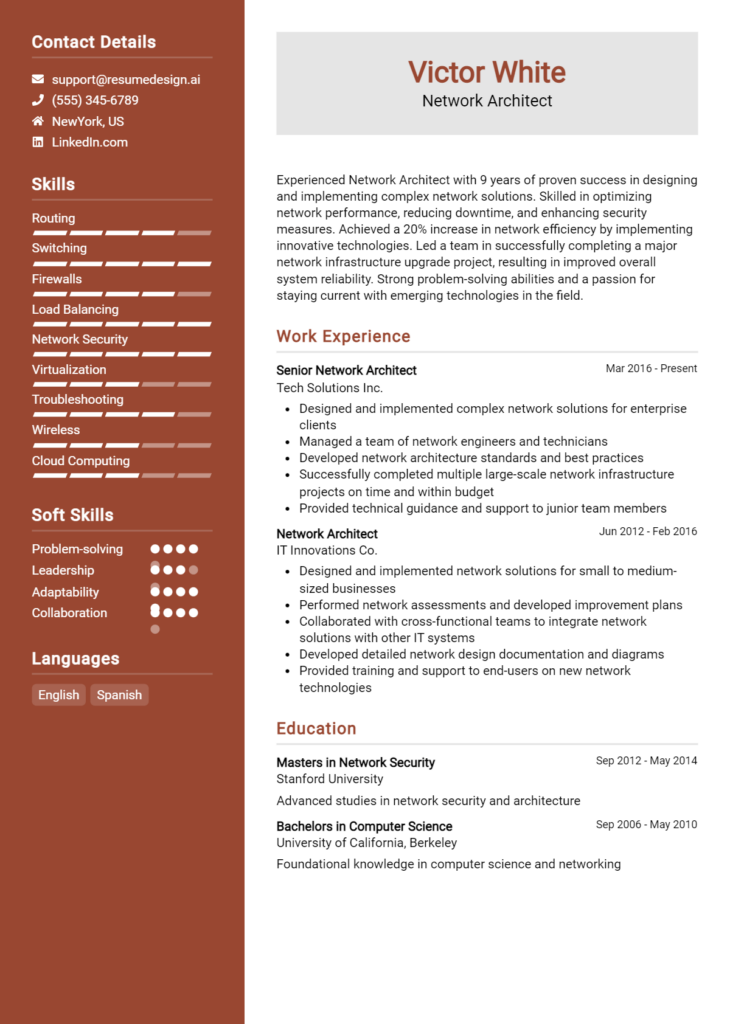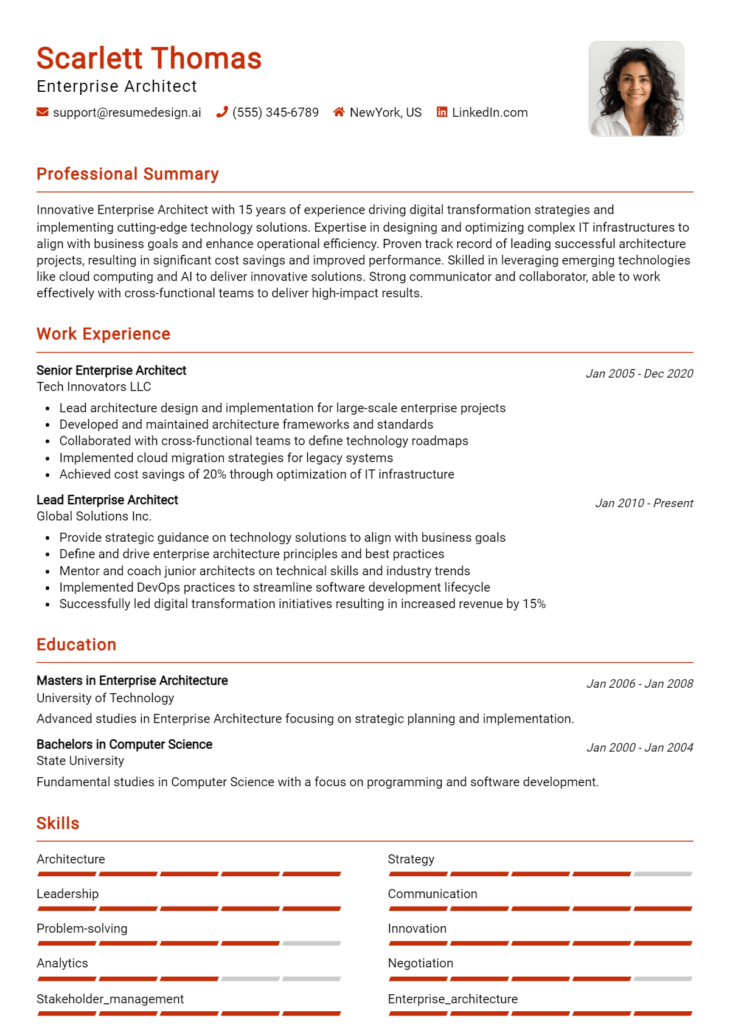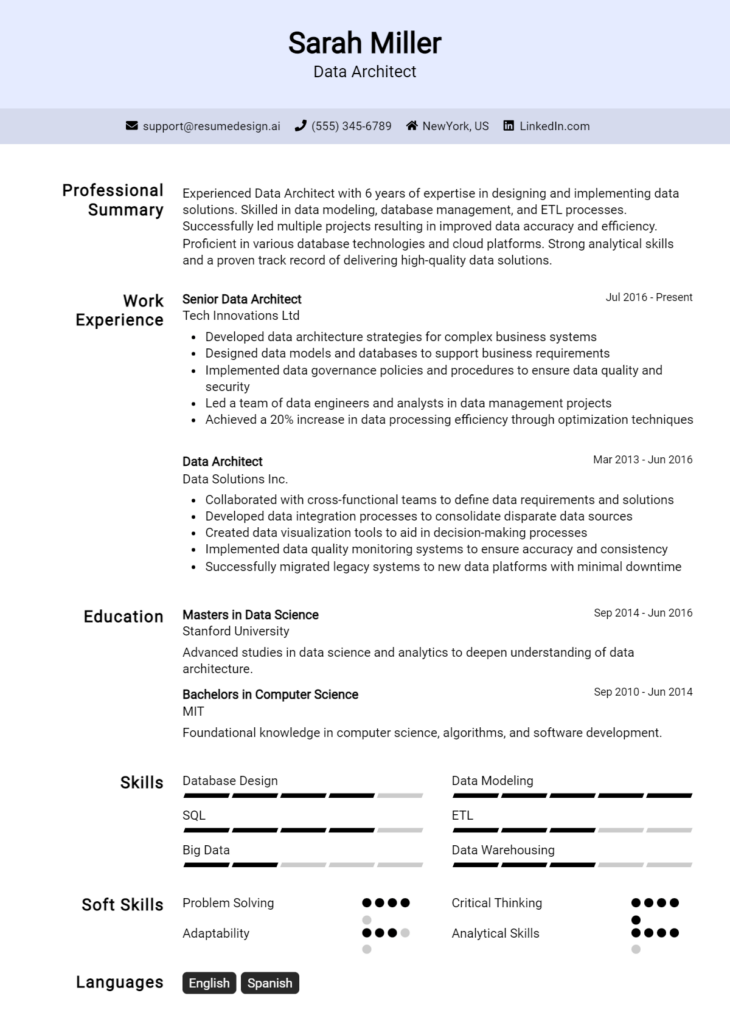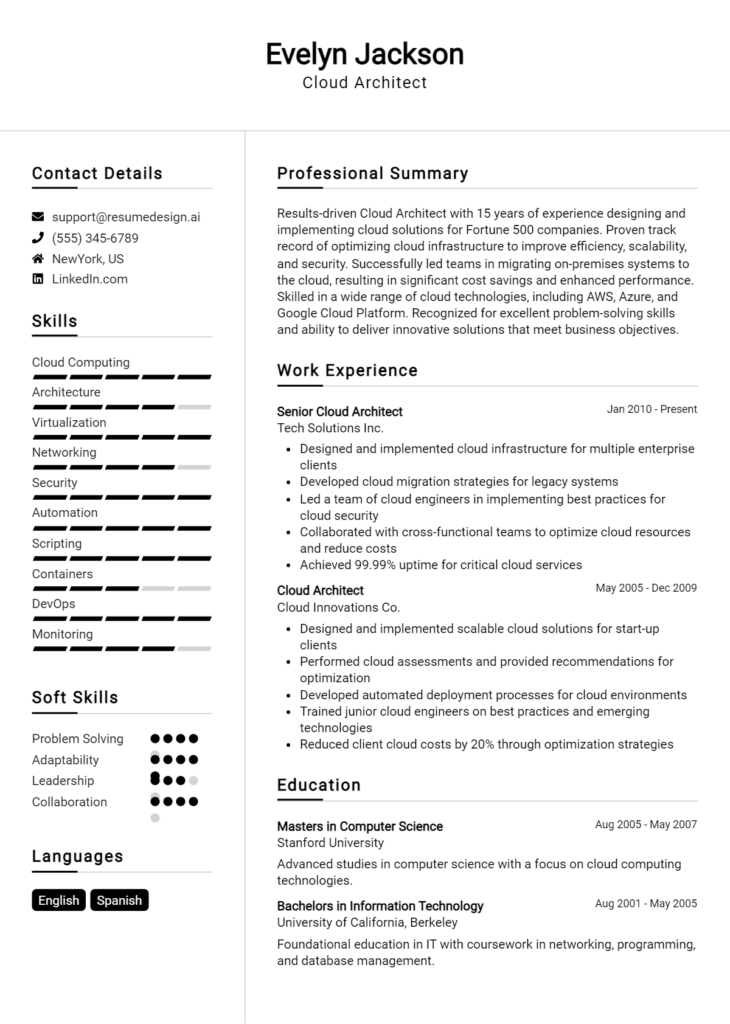Microservices Architect Core Responsibilities
A Microservices Architect plays a crucial role in designing and implementing scalable and efficient microservices architectures, bridging various departments such as development, operations, and business strategy. This professional must possess strong technical skills in cloud services, containerization, and API management, alongside operational expertise and advanced problem-solving abilities. These competencies are vital in aligning technology initiatives with organizational goals. A well-structured resume can effectively highlight these qualifications, showcasing the candidate's ability to drive innovation and teamwork.
Common Responsibilities Listed on Microservices Architect Resume
- Design and implement microservices architecture aligned with business objectives.
- Collaborate with cross-functional teams to define and refine project requirements.
- Ensure scalability, reliability, and performance of microservices systems.
- Oversee the integration of microservices with existing systems and applications.
- Establish best practices for microservices development and deployment.
- Monitor and troubleshoot performance issues within microservices.
- Provide technical guidance and mentorship to development teams.
- Stay updated on industry trends and emerging technologies related to microservices.
- Implement CI/CD pipelines for continuous integration and delivery.
- Evaluate and select appropriate tools and technologies for microservices initiatives.
- Facilitate communication between stakeholders to ensure alignment on project goals.
High-Level Resume Tips for Microservices Architect Professionals
In the competitive landscape of technology and software development, a well-crafted resume is crucial for Microservices Architect professionals. As the first impression you make on potential employers, your resume needs to effectively reflect not only your technical skills but also your notable achievements in the field. A resume is more than just a list of past jobs; it's a marketing tool that showcases your expertise in designing scalable, efficient microservices architectures. This guide will provide practical and actionable resume tips specifically tailored for Microservices Architect professionals, ensuring that you stand out in a crowded job market.
Top Resume Tips for Microservices Architect Professionals
- Tailor your resume to the job description by incorporating relevant keywords and phrases that match the requirements of the position.
- Highlight your experience with microservices architecture, including specific frameworks and technologies you have worked with, such as Spring Boot, Docker, or Kubernetes.
- Quantify your achievements by including metrics that demonstrate your impact, such as reduced system downtime, increased application performance, or improved deployment times.
- Showcase your understanding of cloud platforms and services, detailing your experience with AWS, Azure, or Google Cloud in relation to microservices.
- Include any relevant certifications or training that reinforce your qualifications in microservices and related technologies.
- Demonstrate your ability to collaborate with cross-functional teams, highlighting any leadership roles or successful projects that involved multiple stakeholders.
- Use clear and concise language to describe your responsibilities and accomplishments, making it easy for hiring managers to quickly assess your suitability for the role.
- Incorporate a section for technical skills that lists programming languages, tools, and methodologies relevant to microservices development.
- Keep your resume format clean and professional, ensuring that it is easy to read and visually appealing.
By implementing these tips, you can significantly increase your chances of landing a job in the Microservices Architect field. A polished resume that effectively showcases your skills, achievements, and relevant experience will not only catch the attention of hiring managers but also set you apart as a strong candidate in a competitive environment. Remember, your resume is your personal marketing tool—make it count!
Why Resume Headlines & Titles are Important for Microservices Architect
In the competitive field of microservices architecture, a well-crafted resume headline or title plays a crucial role in capturing the attention of hiring managers. A strong headline serves as a powerful first impression, succinctly summarizing a candidate's key qualifications and expertise in just a few words. It is essential that the headline is concise, relevant, and directly related to the specific job being applied for, as this allows candidates to stand out among numerous applicants. An impactful title not only draws the reader in but also sets the tone for the rest of the resume, indicating that the applicant possesses the skills and experience necessary to excel in the role of a Microservices Architect.
Best Practices for Crafting Resume Headlines for Microservices Architect
- Keep it concise: Aim for a headline that is brief and to the point, ideally no longer than one or two lines.
- Be role-specific: Clearly indicate the position you are applying for to avoid ambiguity.
- Highlight key skills: Incorporate relevant technical skills or methodologies that align with the job requirements.
- Showcase experience level: Specify your years of experience or seniority to immediately communicate your expertise.
- Use impactful language: Choose strong action verbs or adjectives to convey confidence and capability.
- Avoid jargon: Ensure the language is accessible, avoiding overly technical terms that may confuse non-technical recruiters.
- Tailor for each application: Customize your headline for each position to ensure relevance to the specific job description.
- Incorporate achievements: If space allows, include notable accomplishments or certifications to enhance credibility.
Example Resume Headlines for Microservices Architect
Strong Resume Headlines
Innovative Microservices Architect with 10+ Years in Cloud-Native Solutions
Results-Driven Microservices Architect Specializing in Agile Development and CI/CD Pipeline
Expert Microservices Architect Focused on Performance Optimization and Scalability
Weak Resume Headlines
Microservices Architect Looking for Job
Experienced IT Professional
The strong headlines are effective because they are specific, highlight relevant experience, and communicate the candidate's unique value proposition, thus making them memorable and appealing to hiring managers. In contrast, the weak headlines fail to impress due to their vagueness and lack of detail; they do not convey any particular skills or achievements, leaving the reader with little incentive to continue reviewing the resume. A powerful headline can significantly enhance a candidate's chances of being noticed in a crowded job market.
Writing an Exceptional Microservices Architect Resume Summary
A well-crafted resume summary is essential for a Microservices Architect, as it serves as the first impression a candidate makes on hiring managers. In a competitive job market, a strong summary quickly captures attention by effectively showcasing key skills, relevant experience, and notable accomplishments pertinent to the job role. It should be concise, impactful, and tailored specifically to the position being applied for, ensuring that it communicates the candidate's value proposition in just a few compelling sentences.
Best Practices for Writing a Microservices Architect Resume Summary
- Quantify Achievements: Use numbers and metrics to demonstrate the impact of your work.
- Highlight Relevant Skills: Focus on key skills related to microservices architecture, such as cloud computing, containerization, and API management.
- Tailor for the Job Description: Customize your summary to reflect the specific requirements and language of the job listing.
- Use Action-Oriented Language: Begin sentences with strong action verbs to convey confidence and proactivity.
- Keep it Concise: Aim for 2-4 sentences that deliver maximum impact without unnecessary fluff.
- Showcase Problem-Solving Abilities: Include examples of how you’ve tackled challenges in previous roles.
- Emphasize Collaboration: Highlight your experience working in cross-functional teams, a vital aspect of microservices architecture.
- Stay Current: Mention familiarity with the latest trends and technologies in microservices and cloud platforms.
Example Microservices Architect Resume Summaries
Strong Resume Summaries
Innovative Microservices Architect with over 8 years of experience in designing and implementing scalable cloud-based solutions. Successfully led a team to migrate a monolithic application to microservices architecture, resulting in a 40% reduction in deployment time and a 30% increase in system performance.
Results-driven Microservices Architect with a proven track record of delivering high-quality software solutions. Spearheaded the development of a microservices framework that decreased application load time by 50%, significantly enhancing user experience and customer satisfaction.
Dynamic Microservices Architect skilled in leveraging containerization technologies such as Docker and Kubernetes to optimize application deployment. Architected a multi-cloud strategy that improved uptime by 99.9% and reduced operational costs by 20%.
Weak Resume Summaries
Experienced software architect with a background in microservices. I have worked on various projects and am familiar with cloud technologies.
Microservices Architect with knowledge of modern software development practices. I am looking for a position where I can utilize my skills.
The strong resume summaries are considered effective because they provide specific achievements, include quantifiable outcomes, and directly relate to the responsibilities of a Microservices Architect. They utilize clear, action-oriented language that conveys confidence and expertise. In contrast, the weak summaries lack detail and quantifiable results, making them generic and less compelling. They do not effectively showcase the candidate's capabilities or relevance to the role, which could lead to missed opportunities during the hiring process.
Work Experience Section for Microservices Architect Resume
The work experience section of a Microservices Architect resume is critical in demonstrating the candidate's technical acumen, team management capabilities, and track record of delivering high-quality products. This section not only showcases the depth of a candidate's expertise in microservices architecture but also highlights their ability to work collaboratively across teams to drive project success. By quantifying achievements such as successful project delivery timelines, cost reductions, or performance improvements, candidates can effectively illustrate their impact on previous organizations. Aligning this experience with industry standards ensures that the candidate's qualifications resonate with potential employers.
Best Practices for Microservices Architect Work Experience
- Use clear and concise language to describe responsibilities and achievements.
- Quantify results whenever possible, such as percentage improvements or cost savings.
- Highlight leadership roles and collaborative efforts within cross-functional teams.
- Focus on specific technologies and frameworks utilized in microservices development.
- Align your experiences with industry standards and best practices.
- Include relevant certifications or training that support your expertise.
- Tailor your experience to showcase skills that match the job description.
- Emphasize problem-solving skills and the ability to overcome technical challenges.
Example Work Experiences for Microservices Architect
Strong Experiences
- Led a team of 10 developers in the successful migration of a monolithic application to a microservices architecture, reducing deployment times by 40% and improving system scalability.
- Implemented a service mesh that improved inter-service communication efficiency by 30%, resulting in a 25% reduction in overall application latency.
- Collaborated with product managers and stakeholders to define microservices architecture, which increased product delivery speed by 50% over a six-month period.
- Designed and deployed a robust CI/CD pipeline that enhanced the team's delivery capabilities, achieving 99.9% uptime and significantly decreasing release cycle times.
Weak Experiences
- Worked on microservices projects in a team setting.
- Assisted in the development of applications.
- Participated in meetings about architecture improvements.
- Contributed to various software development tasks.
The examples provided showcase strong experiences because they are specific, quantifiable, and demonstrate a clear impact on the organization's performance. Each bullet point highlights leadership, collaboration, and technical expertise, making the candidate's contributions clear and compelling. In contrast, the weak experiences lack specificity and measurable outcomes, making them less impactful and failing to demonstrate the candidate's true capabilities as a Microservices Architect.
Education and Certifications Section for Microservices Architect Resume
The education and certifications section of a Microservices Architect resume is crucial as it encapsulates the candidate's academic achievements and professional development in a rapidly evolving field. This section not only showcases the foundational knowledge acquired through formal education but also emphasizes industry-relevant certifications that reflect a commitment to staying current with the latest technologies and best practices. By including relevant coursework, certifications, and specialized training, candidates can significantly enhance their credibility and demonstrate alignment with the specific requirements of the Microservices Architect role, effectively setting themselves apart from other applicants.
Best Practices for Microservices Architect Education and Certifications
- Prioritize relevant degrees, such as Computer Science, Software Engineering, or Information Technology.
- Highlight industry-recognized certifications like AWS Certified Solutions Architect or Certified Kubernetes Administrator.
- Include specific coursework or projects that relate directly to microservices architecture, cloud computing, and distributed systems.
- Utilize clear formatting to make certifications and education easily scannable for hiring managers.
- Keep the information up-to-date, ensuring that all credentials are current and applicable to the role.
- Showcase any specialized training or workshops attended that focus on microservices, DevOps, or agile methodologies.
- Consider adding links to online profiles or repositories showcasing related work or projects.
- Use concise descriptions to clarify the relevance of each credential to the Microservices Architect position.
Example Education and Certifications for Microservices Architect
Strong Examples
- Bachelor of Science in Computer Science, University of Technology (2015)
- AWS Certified Solutions Architect – Associate (2022)
- Microservices Architecture: Make a Real-World Application with Spring Boot (Coursera, 2021)
- Certified Kubernetes Administrator (CKA) (2023)
Weak Examples
- Associate Degree in Arts (2010)
- Certification in Basic Computer Skills (2018)
- Microsoft Office Specialist Certification (2019)
- High School Diploma (2008)
The examples listed as strong illustrate relevant academic qualifications and certifications that are directly applicable to the role of a Microservices Architect, showcasing specialized knowledge and professional expertise in the field. In contrast, the weak examples reflect outdated or irrelevant qualifications that do not align with the specific demands of the position, potentially diminishing the candidate's appeal to employers seeking advanced skills and knowledge in microservices architecture.
Top Skills & Keywords for Microservices Architect Resume
In the rapidly evolving landscape of software architecture, the role of a Microservices Architect is critical for organizations looking to enhance their scalability, flexibility, and resilience. A well-crafted resume for this position must highlight a blend of both hard and soft skills that showcase not only technical expertise but also the ability to collaborate and communicate effectively within diverse teams. By emphasizing these skills, candidates can demonstrate their capability to design, implement, and manage microservices architectures that align with business goals and drive innovation. For those interested in enhancing their resumes, focusing on the right skills and showcasing relevant work experience can make a significant difference in standing out to potential employers.
Top Hard & Soft Skills for Microservices Architect
Soft Skills
- Effective Communication
- Team Collaboration
- Problem Solving
- Critical Thinking
- Adaptability
- Time Management
- Conflict Resolution
- Empathy
- Leadership
- Strategic Planning
Hard Skills
- Microservices Architecture Design
- API Development and Management
- Cloud Platforms (AWS, Azure, GCP)
- Containerization (Docker, Kubernetes)
- DevOps Practices
- Continuous Integration and Continuous Deployment (CI/CD)
- Programming Languages (Java, Python, Node.js)
- Database Management (SQL, NoSQL)
- Monitoring and Logging Tools (Prometheus, ELK Stack)
- Security Best Practices in Microservices
Stand Out with a Winning Microservices Architect Cover Letter
Dear [Hiring Manager's Name],
I am excited to apply for the Microservices Architect position at [Company Name], as advertised on [Job Board/Company Website]. With over [X years] of experience in software architecture and a deep understanding of cloud-native solutions, I have successfully designed and implemented microservices-based architectures that enhance scalability, maintainability, and performance. My expertise in tools such as Docker and Kubernetes, combined with my proficiency in programming languages like Java and Node.js, has empowered me to lead teams in delivering robust and efficient systems that align with business objectives.
At [Previous Company Name], I spearheaded the transition from a monolithic architecture to a microservices-based framework, resulting in a [percentage]% increase in deployment frequency and a significant reduction in downtime. By employing best practices in API design and leveraging service mesh technologies, I ensured seamless communication between services while maintaining high levels of security and compliance. My collaborative approach has allowed me to work closely with cross-functional teams, mentoring developers and fostering a culture of continuous improvement, ensuring that all stakeholders are aligned and informed throughout the development lifecycle.
I am particularly drawn to [Company Name] because of its commitment to innovation and excellence in [specific industry or technology]. I am eager to bring my strategic vision and technical skills to your team, driving the adoption of microservices architecture that not only meets current needs but also positions [Company Name] for future growth. I am confident that my ability to analyze complex challenges and devise scalable solutions will contribute to the ongoing success of your projects.
Thank you for considering my application. I look forward to the opportunity to discuss how my experience and passion for microservices architecture can benefit [Company Name]. Please feel free to contact me at [Your Phone Number] or [Your Email] to schedule a conversation.
Sincerely,
[Your Name]
Common Mistakes to Avoid in a Microservices Architect Resume
When crafting a resume for a Microservices Architect position, it is essential to present your skills and experiences effectively. Many candidates, however, fall into common pitfalls that can detract from their qualifications. By avoiding these mistakes, you can enhance your resume's impact and better demonstrate your expertise in microservices architecture. Here are some frequent errors to steer clear of:
Vague Job Descriptions: Failing to provide specific details about your roles and responsibilities can make it challenging for hiring managers to gauge your experience. Use clear and quantifiable examples to highlight your achievements.
Lack of Tailoring: Sending out a generic resume without tailoring it to the specific job description can diminish your chances of getting noticed. Customize your resume for each application by aligning your skills with the requirements of the role.
Ignoring Key Technologies: Microservices architecture often involves various technologies and tools. Not mentioning relevant technologies, such as Docker, Kubernetes, or cloud platforms, can make your resume less appealing to employers looking for specific expertise.
Overemphasis on Soft Skills: While soft skills are important, focusing too much on them without showcasing technical competencies can weaken your candidacy. Balance your resume by highlighting both technical skills and interpersonal abilities.
Neglecting to Showcase Achievements: Simply listing tasks without mentioning the impact of your work fails to convey your value. Include accomplishments that demonstrate how your contributions improved processes or outcomes.
Inconsistent Formatting: A cluttered or inconsistent format can distract from the content of your resume. Ensure a clean, professional layout with uniform font sizes and styles to enhance readability.
Excessive Jargon: While technical terms are necessary, overloading your resume with jargon can alienate readers unfamiliar with specific terms. Strive for clarity and explain complex concepts when appropriate.
Not Highlighting Leadership Experience: As an architect, leadership is a vital aspect of the role. Failing to mention experiences where you led projects or teams may overlook a key qualification that employers value.
Conclusion
As we’ve explored throughout this article, the role of a Microservices Architect is pivotal in designing scalable, efficient, and maintainable systems. Key responsibilities include defining the microservices architecture, ensuring seamless integration between services, and advocating for best practices in development and deployment. Additionally, a strong understanding of cloud technologies, containerization, and distributed systems is essential for success in this role.
In a rapidly evolving tech landscape, it's crucial to stay updated with the latest trends and tools that can enhance your microservices architecture skills. If you're looking to advance in your career, it's time to reflect on your resume and ensure it highlights your expertise and achievements.
We encourage you to take a closer look at your Microservices Architect resume. Utilize resources such as resume templates to create a polished look, or leverage our resume builder for an easy and efficient way to craft your document. Don't forget to browse through our resume examples for inspiration, and consider pairing your resume with a compelling cover letter template to make a strong impression on potential employers.
Take action today: refine your resume and position yourself as the ideal candidate for your next opportunity in microservices architecture!

